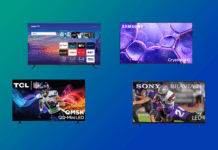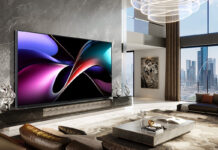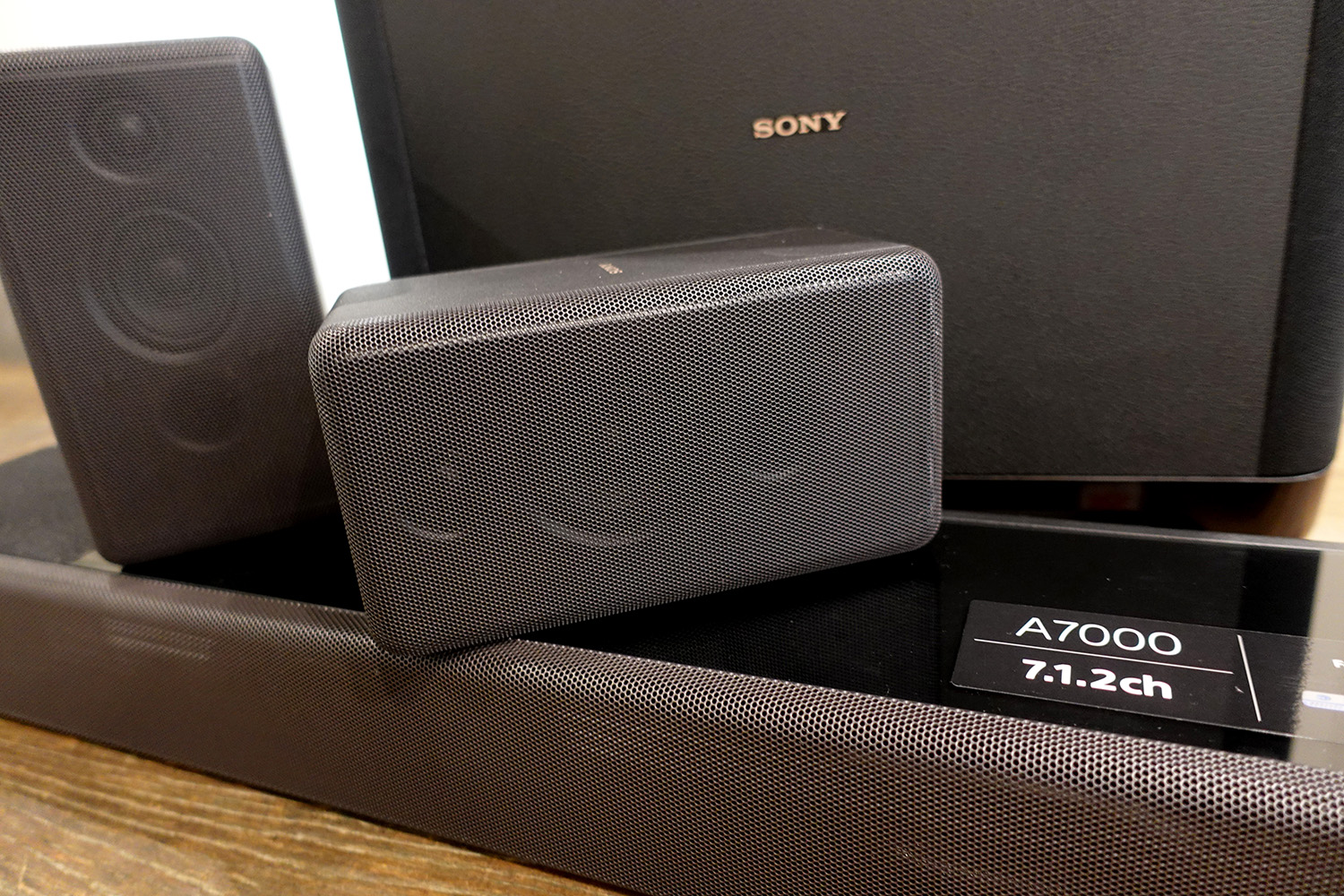 I’ve never owned a sound bar myself, but I completely understand the convenience. With a sound bar you don’t need equipment racks or a nest of cables and it’s pretty simple to set up. But as someone who prioritizes sound reproduction over all other factors, I’ve always been drawn to dedicated speakers, individual surround processors, and amplification.
I’ve never owned a sound bar myself, but I completely understand the convenience. With a sound bar you don’t need equipment racks or a nest of cables and it’s pretty simple to set up. But as someone who prioritizes sound reproduction over all other factors, I’ve always been drawn to dedicated speakers, individual surround processors, and amplification.
That’s why it was with a bit of skepticism that I went into my review of Sony’s latest high-end sound bar solution, the Sony HT-A7000 sound bar system, I wasn’t sure whether it could compete with a standalone solution. After a few weeks of experimentation, I was extremely pleased to say my prejudices about sound bar performances have been put to rest. I found that a sound bar of this calibre can stand head to head against many dedicated home theatre systems.
Specs on Sony HT-A7000 Sound bar system
The Sony HT-A700 sound bar system is made up of three components; the Sony HT-A7000 Sound bar itself, Sony SA-SW5 Subwoofer, and Sony SA-RS3S Surround Speakers.
Specifications on Sony HT-A7000 sound bar
- Size: 51.25 x 3.25 x 5.63”, 19lb 2oz
- Total output: 500w into 11 channels
- Network/Services include Wifi, Chromecast, Spotify Connect, Google Assistant, AirPlay2, Bluetooth
- Codecs: Dolby Atmos, DTS:X
- Input/Output: 2 HDMI 4k/60p inputs, HDR compatible with HLG and Dolby Vision support. 1 HDMI eARC supporting output, 1 toslink optical port
Specifications on Sony SA-SW5 subwoofer
- Size: 277 x 409 x 422 mm, 13 kg
- Total Output: 300w
Specifications on Sony SA-RS3S surround speakers
- Size: 100 x 187 x 100 mm
- Total Output: 50w/ch
First thoughts on the Sony HT-A7000 sound bar
The Sony HT-A7000 by itself could be used as a fully standalone unit and the center of your audio setup, as it’s advertised by itself as a 7.1.2 system. The model is comprised of five speakers that point to the front, two “beam” tweeters that bounce off the side walls to create a sensation of surround sound, and two up-firing speakers to provide overhead audio from Atmos and other similar soundtracks. It even has a built-in subwoofer to provide a bit of low-frequency information.
On its own, I found the stereo separation far better than my built-in TV speakers, and while the promised feeling of being surrounded by sound was attempted, in my opinion, its not quite the same as having the actual placement of side or rear speakers to immerse the listener. Similarly, there was some welcome bass impact, and while I thought it was superior to many other sound bars that often feel anemic in this area, the built-in bass couldn’t replace a dedicated subwoofer.
Components connect to base unit wirelessly
Fortunately, anyone choosing the Sony HT-A7000 sound bar system gets the complete system with the included sister components—the SARS3S rear speakers, and the SA-SWS5 model Subwoofer. Both the surrounds and the sub are powered speakers, meaning they have to be plugged into the wall at their location. However, they connect to the Sony A7000 base unit wirelessly, so you don’t need to run speaker wire from the front to the back of your room.
Immersive sound when paired together
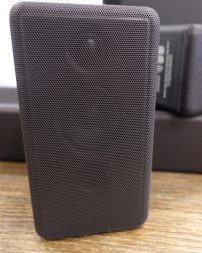 The drivers inside the Sony SARS3S perfectly match those in the A7000, which makes for a highly pleasing soundstage. Often people have differing or larger speakers as their main left and right, with smaller, underpowered speakers for their center and surround options. The huge advantage of this setup is that when sounds are mixed to go from channel to channel the same timbre and quality of the sound, benefiting greatly the sense of immersion.
The drivers inside the Sony SARS3S perfectly match those in the A7000, which makes for a highly pleasing soundstage. Often people have differing or larger speakers as their main left and right, with smaller, underpowered speakers for their center and surround options. The huge advantage of this setup is that when sounds are mixed to go from channel to channel the same timbre and quality of the sound, benefiting greatly the sense of immersion.
If I have one caveat, it’s that the SARS3S’s would be even more powerful if they had up-firing Atmos-style speakers built-in. This would ideally improve the performance of that height signal even more, at mixes like Atmos actually allow exceptional front-to-back discrete mixing, making those swooping helicopters and flights of arrows flying overhead feel all the more present.
Sony SA-SWS5 subwoofer is small but powerful
The SWS may have a small footprint, but with a downward-firing speaker bouncing off its integrated metal plate, it does a fabulous job of extending the Low Frequency channels and genuinely delivering the impact required. This further frees up the bass driver in the Sony HT-A7000 to be used to enrich the left, center and right channel information rather than the dedicated LFE or bass channel. The less it has to work to do everything, the better it is in providing a shade more bass to the sounds from the front and allowing the standalone sub to do the heavy pounding when required.
Connections and inputs on Sony HT-A7000
 The Sony HT-A7000 sound bar has two HDMI inputs and one output that conforms to the eARC specification. This allows a two-way signal between your television and the sound bar, having audio from the TV’s built-in applications play through the unit while having content from the HDMI inputs or built-in streaming services like Spotify play through the speakers while displaying content on the screen.
The Sony HT-A7000 sound bar has two HDMI inputs and one output that conforms to the eARC specification. This allows a two-way signal between your television and the sound bar, having audio from the TV’s built-in applications play through the unit while having content from the HDMI inputs or built-in streaming services like Spotify play through the speakers while displaying content on the screen.
My own setup is a bit challenging, with an older TV that’s never been particularly good at ARC handshaking. Still, even in this circumstance, I was able to get things working with optical within minutes, even if the convenience of single-cable HDMI for in and out eluded me. Being a universal sound bar you don’t need to hook this up to a Sony brand TV, and almost every modern set will be able to work fantastically well with only a few clicks of your remote.
Wireless connection to the subwoofer and the surround speakers could not have been easier and was literally plug and play. Gone are the days of having to hold down strange button combinations, and I was up and running with full surround in less than a minute.
You can either transmit Bluetooth to a pair of headphones or receive Bluetooth from your device to play on the speakers, another excellent touch.
Performance of Sony HT-A7000 sound bar system
From the outset, I was extremely pleased with the output from the combination of the Sony HT-A7000 and the additional sub and surround speakers. While still not at the level of some higher-end dedicated home theatre setups, there’s plenty to admire about how Sony has seemed to wring the most that it can within such a convenient form factor. At just under 20 lbs the Sony HT-A7000 isn’t some piddly thing, and it handled everything from Blu-ray audio music to thunderous action movies with aplomb.
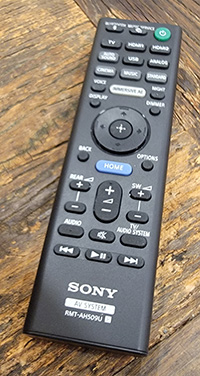 The remote is a relatively straightforward affair, but the minimal menu system was extremely easy to follow and its automated calibration setup did the job quickly and accurately.
The remote is a relatively straightforward affair, but the minimal menu system was extremely easy to follow and its automated calibration setup did the job quickly and accurately.
I’m no gamer, but for those of you with both of the main models of modern consoles, you’ll be able to plug them into the unit and immediately be greeted with powerful sound. Unfortunately, the unit does not support a variable refresh rate, meaning that you’ll need to plug directly into your television rather than having those signals pass through.
I went through many titles at the setup, from big action movies to music concerts to quiet dialogue pieces and always found the sound rich and clear. It was never brittle or piercing. On the most active Atmos mixes like Mad Max: Fury Road you got a small sense of the capabilities of the top-firing speakers, but more than that the heavily active surround mix helped fill out the room. It’s definitely possible to crank things up to obnoxious levels without ever hearing any rattling or egregious distortion, which is obviously a plus.
Should you choose the Sony HT-A7000 sound bar system?
This is a system meant to make your seat rumble and the soundtrack come to life, and it does a very good job at doing just that. Other than adding a top firing speaker to the surrounds, it might be nice to be able to expand the system even further, creating a true 7.1 setup with another pair of standalone speakers.
I wish it had an Ethernet input—given that the streaming capabilities are audio-only it may not be bothersome to most, but I for one like to have as much taken off my Wifi as possible to maximize throughput for those devices that demand a wire-free connectivity.
I would also love a more overt pure music or direct mode, shifting the Sony HT-A7000 into a “stereo only” setup with a single click for when playing back music. Many people like using all the speakers they paid for at all times, but I generally prefer having a quick access to hear the source sound in the way that was originally mixed.
I have zero complaints about the ability to decode the latest object-based surround codecs like Atmos and DTS:X, but you could tweak that capability further in the setup, dialling in those additional top-firing speakers even better.
Final take on Sony sound bars
Colour me convinced: given the right setup a sound bar of this caliber can rival many dedicated home theatre systems, and in many ways actually goes beyond some of their capabilities.
While the Sony HT-A7000 sound bar itself does a decent job, it’s the addition of the dedicated subwoofer and separate surround speakers that truly takes this to the next level. With its capabilities to decode the latest surround codecs from both disc and streaming, its solid and robust construction, and its ease of setup and its powerful audio impact, this will be for many the setup that will bring the dream of true home theatre performance with a sound bar form-factor to reality.
You can find the Sony HT-A7000 sound bar system on Best Buy.

